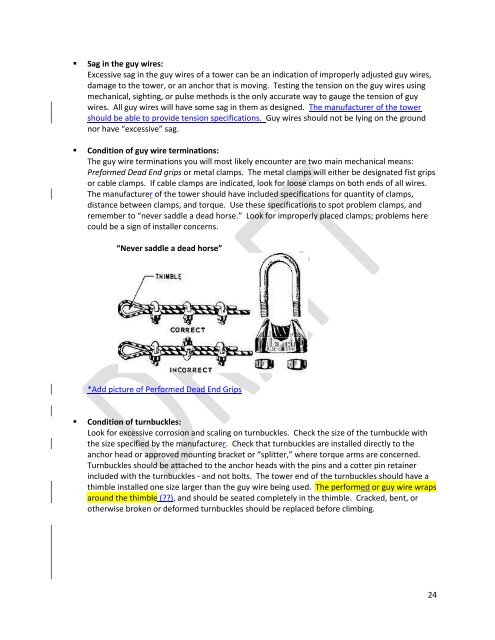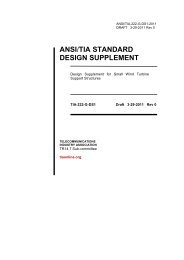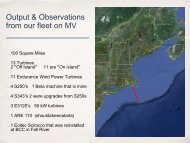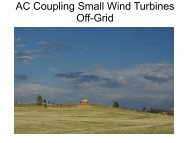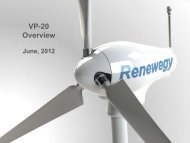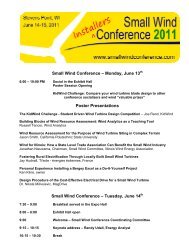Best Practices in Small Wind: Tower Climbing Safety
Best Practices in Small Wind: Tower Climbing Safety
Best Practices in Small Wind: Tower Climbing Safety
Create successful ePaper yourself
Turn your PDF publications into a flip-book with our unique Google optimized e-Paper software.
� Sag <strong>in</strong> the guy wires:<br />
Excessive sag <strong>in</strong> the guy wires of a tower can be an <strong>in</strong>dication of improperly adjusted guy wires,<br />
damage to the tower, or an anchor that is mov<strong>in</strong>g. Test<strong>in</strong>g the tension on the guy wires us<strong>in</strong>g<br />
mechanical, sight<strong>in</strong>g, or pulse methods is the only accurate way to gauge the tension of guy<br />
wires. All guy wires will have some sag <strong>in</strong> them as designed. The manufacturer of the tower<br />
should be able to provide tension specifications. Guy wires should not be ly<strong>in</strong>g on the ground<br />
nor have “excessive” sag.<br />
� Condition of guy wire term<strong>in</strong>ations:<br />
The guy wire term<strong>in</strong>ations you will most likely encounter are two ma<strong>in</strong> mechanical means:<br />
Preformed Dead End grips or metal clamps. The metal clamps will either be designated fist grips<br />
or cable clamps. If cable clamps are <strong>in</strong>dicated, look for loose clamps on both ends of all wires.<br />
The manufacturer of the tower should have <strong>in</strong>cluded specifications for quantity of clamps,<br />
distance between clamps, and torque. Use these specifications to spot problem clamps, and<br />
remember to “never saddle a dead horse.” Look for improperly placed clamps; problems here<br />
could be a sign of <strong>in</strong>staller concerns.<br />
“Never saddle a dead horse”<br />
*Add picture of Performed Dead End Grips<br />
� Condition of turnbuckles:<br />
Look for excessive corrosion and scal<strong>in</strong>g on turnbuckles. Check the size of the turnbuckle with<br />
the size specified by the manufacturer. Check that turnbuckles are <strong>in</strong>stalled directly to the<br />
anchor head or approved mount<strong>in</strong>g bracket or “splitter,” where torque arms are concerned.<br />
Turnbuckles should be attached to the anchor heads with the p<strong>in</strong>s and a cotter p<strong>in</strong> reta<strong>in</strong>er<br />
<strong>in</strong>cluded with the turnbuckles - and not bolts. The tower end of the turnbuckles should have a<br />
thimble <strong>in</strong>stalled one size larger than the guy wire be<strong>in</strong>g used. The performed or guy wire wraps<br />
around the thimble (??), and should be seated completely <strong>in</strong> the thimble. Cracked, bent, or<br />
otherwise broken or deformed turnbuckles should be replaced before climb<strong>in</strong>g.<br />
24


